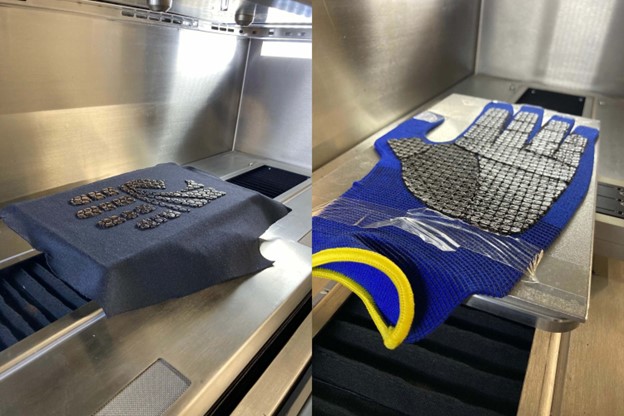
Protective gloves, such as those used for work, sport or household gardening, get their protective function from a special coating. This coating provides abrasion resistance, makes the material waterproof and resistant to chemicals or oil, and even protects against cuts and punctures.
Until now, coatings made of oil-based polymers, nitrile rubber or latex have been the main materials used. Using innovative technologies, scientists at the German Institutes of Textile and Fiber Research Denkendorf (DITF) have succeeded in developing a robust yet flexible glove coating using environmentally friendly lignin in a 3D printing process.
Coatings that are subject to mechanical stress always suffer from a certain degree of abrasion that is dispersed in the surrounding area. This is also the case with coated protective gloves. In order to avoid long-term pollution of the environment, materials should be used whose abrasion particles are biodegradable. The aim of DITF’s research was to improve conventional protective equipment and integrate more sustainable materials.
The biopolymer lignin is a natural component of plant cells that is produced in large quantities as a by-product of paper manufacturing. Due to its properties, it represents an environmentally friendly alternative to oil-based coating polymers. The scientists developed biopolymer compounds containing lignin, which were used to produce thermoplastic materials that can be processed using 3D printing.
Lignin has few polar groups, which make lignins hydrophobic and therefore insoluble in water. For this reason, they biodegrade slowly, which means that they are particularly suitable for durable coating materials.
Despite this durability, lignin particles that are released into the environment through abrasion biodegrade faster than the abrasion of conventional coatings. This is due to the much higher surface-to-volume ratio.
The use of 3D printing makes it possible to produce the coating precisely and efficiently. The 3D printing process also makes it possible to adapt the glove to the individual needs of the wearer. This increases wearer comfort and promotes freedom of movement.
The research project shows that the use of lignin not only offers ecological benefits, but that protective gloves coated with it are also particularly durable and resistant, meeting safety standards. The project was funded by the Ministry of Rural Areas and Consumer Protection of the State of Baden-Württemberg as part of the Bioeconomy Innovation and Investment Program for Rural Areas “BIPL BW – Innovation” (funding reference BWIN220081).
 TEXTILES.ORG
TEXTILES.ORG


